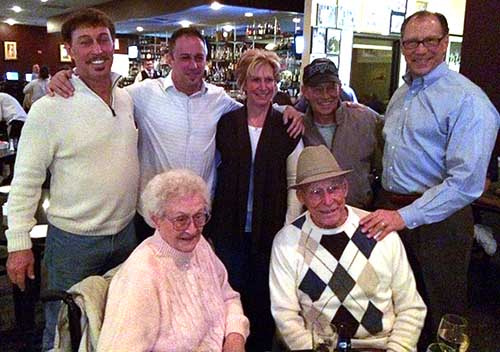
The Homes for Life story begins in 2002 in Broomall, Pennsylvania, with my mom – Margaret Mary “Peg” Aquilino – who became an amputee as a result of a fall and severe osteoporosis.
Suddenly, her world changed.
Mom had a walker, but she was very limited in what she could do.
My parents’ bedroom and bath were on the second floor, but the staircase was too narrow for a stair lift. So Dad moved their bed to the living room, purchased a portable toilet and helped Mom sponge bathe downstairs.
She spent her days in a chair, watching TV and falling asleep.
It was far from ideal. Nevertheless, Mom accepted it all, complained little and did her best to keep smiling.
But her environment had become disabling.
We wanted something better for Mom’s quality of life, so we tried to find local experts – to no avail. Eventually, we stumbled upon a few builders and contractors who claimed they knew the design requirements to help people like Mom who had physical limitations – but in reality, they knew very little.
After a year, we finally found a small ranch that we could renovate to make it more accessible for Mom. Financially, it was daunting for my parents to buy and renovate a home while living in another; but fortunately, we are a family of craftsmen. Plus, the neighborhood was full of tradespeople who were very fond of Mom, so they insisted on doing all the renovations free of charge. No one would accept a penny for their labor! All we had to do was supply the materials, the sandwiches and the beverages every weekend.
In 2004, after nine months of work, the ranch was finally ready. My parents never saw the home until it was finished, and when they did – they were ecstatic.
After they moved into their new home, life got better for Mom.
She couldn’t do everything she used to do, but her quality of life had improved significantly.
The home we renovated allowed Mom to live more comfortably, independently, safely – and with dignity – for 10 years.
When she passed away in 2015, we knew that because of my dad’s unbridled dedication and a neighborhood full of support, the last years of her life were far better than they would have been otherwise.
That experience taught me a lot.
If I had to do it over again, I’d do things differently. And that’s why I started Homes for Life.
Today, 8,000 people retire every day in the U.S. If they want to live in place as they age – and 90 percent say they do – they’re going to need accessible homes so they can live a higher quality of life, at home.
But – as I discovered with Mom – here’s the problem:
Most homes today don’t have what it takes for people to live in place as they age.
In fact, less than 2.5 percent of single-family homes today have even most basic accessible design features, much less anything customized, according to the Harvard Joint Center for Housing Studies.
Plus, most builders today don’t know what it really takes to build an accessible home that works for people now and in the future, if circumstances change. As I discovered, the knowledge gap is significant.
And of course, most people aren’t surrounded by a local community of tradespeople willing to renovate an existing home into an accessible home for free. In reality? Such renovations can cost hundreds of thousands of dollars.
The truth is this:
Today there are thousands of people just like my mom – people who need someone to build them a custom, beautiful, accessible home for life. A home they can stay in forever.
And – as a legacy to Peg Aquilino – that is exactly what we’re doing today in the Carolinas at Homes for Life.
If you want to learn more about what we can do for you or someone in your family, I invite you to contact us directly at 919-619-1339 or email us at info@homes4life.net.
Bob Aquilino
Founder and President, Homes for Life